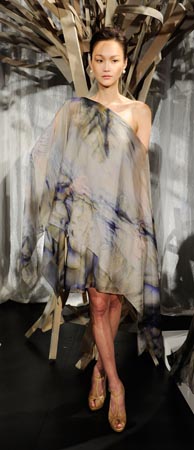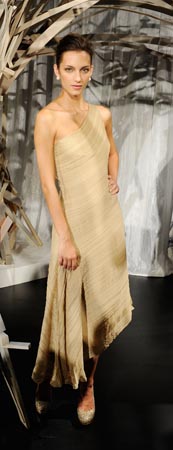|

TO DEFINE the Tadashi Shoji name
brand, we can simply say that it is a ‘work of art.’ He was born
in Sandai, Japan and moved to Tokyo to study fine art. Eventually
he moved from Tokyo to Los Angeles, California, where he attended
college. There, his artistic point-of-view became more specific
and he grew interested in fashion design. He received his fashion
degree and eventually his name went down in history in the fashion
world as a popular brand among women looking to buy beautifully
structured pieces at affordable prices. In 1982, the Tadashi Shoji
collection was finally considered to be ‘the next big thing’ in
the fashion industry.
During the spring–summer 2011 New York Fashion Week
shows, we were invited to take a dive into Shoji’s world and speak
to him in a one-on-one interview to gain his personal perspective
in his own, creative universe of artistic beauty he has come to
form from an early age and making it a world for others to enter.
He expressed a wide interest in beauty and elegance. His fashion
show was revealed as a presentation to viewers.
While impatiently waiting to enter the Box at Lincoln
Center, the main showroom for some designers, we wondered what creative
idea Shoji could have built. Once making one’s way through the open
doors, we were not surprised to see the artistic visions the designer
outlined, not only in the clothing but as well as in the atmosphere.
The main theme for the new season’s collection was
based on ‘elegance and romance’ in the fifteenth century. Twenty-one
models stood wearing gowns under a fort-like creation formed with
many wood pieces intertwined, thus reflecting a historical image.
The room was dark, reflecting an atmosphere of mystery and speculation.
The gowns were absolutely exquisite and tasteful. There were long
gowns and knee-high dresses, each one showed a stunning and striking
image for the observers to take in as they made their way around
the room. There was a feeling of tranquillity as Shoji focused on
the uncomplicated elegance of the female body in soft tones of beige
and grey. Inspired by line and shadow, the collection’s emphasis
on asymmetric necklines and hems create long romantic gowns, which
move around the body.
We can imagine the traditional kimono reinvented for
the modern woman, seen in the tomoeri necklines, the long kimono
sleeves and the obi exchanged for a bow of ribbon.
Many pieces were carefully detailed and formed to highlight
a delicate feature. The materials were mainly of silk and chiffon,
such textures generated a sense of perfection and simplicity as
they hugged around a woman’s body.
Asking Shoji why he decided to present his show as
a presentation he answered, ‘A presentation is more intimate than
a show would be. In a show the models walk down the runway and we
aren’t able to see and take time to observe … in a presentation
there is more intimacy.’
Shoji explained to us his adventure into the fashion
world: ‘I did not know that I would become a designer.’ His aim
was to come to America and eventually he became involved in the
fashion world. As he described to us how women should feel like
when they dress, he told us, ‘Women should feel confident.’ Watching
the models stand and show off the designer’s artistic pieces, we
can see that confidence that Shoji spoke of. In terms of the young
generation and those who look up to Shoji, he said, ‘For the young
generation, they should go for what they believe in.’
Spring 2011 is, as the season goes, a time of change.
Tadashi Shoji is a designer who represents our future: in the words
of Lucire travel editor Stanley Moss, he is someone who transcends
global limits. Upon leaving the room, we anxiously wait to see what
other ideas such an artistic designer will come up with in the future.
•
|
 |
Left Tadashi Shoji, pictured with
Lucire travel editor Stanley Moss, photographed at Shoji’s
trunk show on October 21 at Bloomingdale’s Fashion Island in
Newport Beach, California. Shoji says business has rebounded, with
excellent demand for the 2010 collection. A new Tadashi Shoji boutique
will open in Shanghai in 2011. Below More from Tadashi Shoji’s
New York Fashion Week presentation.


Lola Saab is Paris editor of Lucire.
Stanley Moss is travel editor of Lucire.
Morgan Davison is an editorial assistant at Lucire.
|

